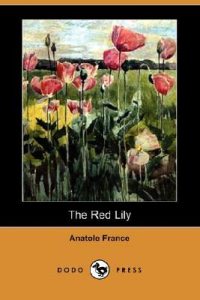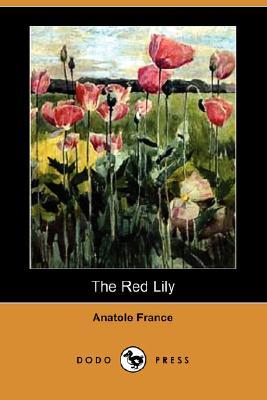The Red Lily – Anatole France – 1898
Reviewed by: Jason Tomes Date: 10 September 2004
With its Late Romantic emphasis on passion and beauty, “The Red Lily” is very much a novel of its time (the  1890s). The settings are contemporary Paris and Florence. The people are rich, cultured, and fashionable: Parisian socialites, aristocrats, artists, and politicians. At the heart of the book is a lovely young woman, Therese Martin-Belleme, the daughter of a new-rich banker, married to an aspiring titled politician. Husband and wife are indifferent to one another. Therese has a paramour, Robert, but finds him rather dull too. She leaves both men behind to spend a long holiday in Tuscany, where she falls in love with a jealous sculptor named Jacques Dechartre. He is given to exclamations of the following sort: “Like incense I breathe the charm of your intellect, the inspiration of your courage, the pride of your soul. When you speak I seem to see your soul on your lips, and I die because I cannot press mine to yours. Your soul is for me but the expression of your beauty.”
1890s). The settings are contemporary Paris and Florence. The people are rich, cultured, and fashionable: Parisian socialites, aristocrats, artists, and politicians. At the heart of the book is a lovely young woman, Therese Martin-Belleme, the daughter of a new-rich banker, married to an aspiring titled politician. Husband and wife are indifferent to one another. Therese has a paramour, Robert, but finds him rather dull too. She leaves both men behind to spend a long holiday in Tuscany, where she falls in love with a jealous sculptor named Jacques Dechartre. He is given to exclamations of the following sort: “Like incense I breathe the charm of your intellect, the inspiration of your courage, the pride of your soul. When you speak I seem to see your soul on your lips, and I die because I cannot press mine to yours. Your soul is for me but the expression of your beauty.”
Though the book is not at all sexually explicit, its open championing of sexual love without regard to marriage vows must have made it appear decidedly ‘advanced’ in its day (especially to English readers). It is an intelligent attempt to capture the joys and pains of a passionate love affair.
Unfortunately, the characters do not really come alive. It so happened that I read this novel immediately after a volume of Chekhov’s short stories. “The Red Lily” suffered severely from the comparison. While Chekhov seems to present real men and women, Anatole France deals with obviously artificial literary creations. The minor individuals exchanging bon mots at dinner-parties could fit into the background of an Oscar Wilde comedy. France’s style, though, clever and fluent, does not harmonise well with the requirements of an essentially naturalistic novel – at least, not in the 1910 translation by Winifred Stephens.
The possible exception to the charge of weak characterisation is Therese herself. She is the overwhelmingly dominant figure, reputedly based on France’s own mistress. For all that we get very close to her, however, she remains something of an ideal of beauty and sensitivity. Her husband and first lover are uninteresting by authorial intent. The love of her life, Dechartre, comes across as a cliche, at least to modern eyes.
A couple of secondary figures are rather predictable vignettes of eccentricity, satirical perhaps, yet sentimentalised. Miss Vivian Bell, the English poetess, enthuses about Dante and calls people ‘dear’ and ‘darling’. This reader frankly found it hard to stomach Choulette, the pious ‘simple-lifer’ who finds poetic inspiration among the poor and lowly. He is scarcely more convincing than the artists in Du Maurier’s “Trilby”.
The scenes in Florence bring to mind Forster’s “A Room with a View”; again, “The Red Lily” comes off worse. If Therese and Jacques had ever turned into flesh and blood, this book could have been an emotional tour de force. As it is, for deeply-felt adulterous passion among continental aristocrats, circa 1900, I would sooner recommend Count Balint Abady and Adrienne Uzdy in Miklos Banffy’s magnificent “They Were Counted”.















